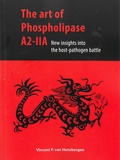The art of Phospholipase A2-IIA
New insights into the host-pathogen battle
Summary
Phospholipase A2-IIA (hGIIA) is a potent bactericidal enzyme that is highly expressed during a bacterial infection. Especially Gram-positive bacteria are susceptible to the hGIIA mechanism of action, which involves degradation of phospholipids. We set out to determine whether the important human pathogens Group A Streptococcus (GAS) and methicillin-resistant Staphylococcus aureus (MRSA) developed specific resistance mechanisms to evade hGIIA mediated killing. The initial screens were performed with transposon libraries. For GAS, we identified and confirmed multiple genes to be involved in hGIIA resistance. Incidentally, we also discovered that, in order to kill GAS, hGIIA requires an important surface structure. A previously unknown modification on this structure allows for hGIIA penetration through the GAS cell wall. For MRSA, we identified and confirmed that the final step of lipoprotein maturation increases hGIIA resistance. We were able to break this resistance by treating MRSA with the “Gram-negative specific antibiotic” globomycin. Finally, we further characterized the hGIIA dependence on the Membrane Attack Complex (MAC) for the killing of Escherichia coli (E. coli). We show that the MAC causes outer membrane damage which allows hGIIA to reach the inner membrane. At the inner membrane, hGIIA can degrade the phospholipids which results in bacterial killing. More insights into the hGIIA resistance mechanisms of Gram-positive bacteria and the mechanism of action against Gram-negative bacteria could lead to novel treatment strategies that allow easier bacterial clearance by the host.
